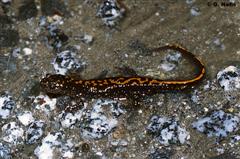Salamander - Santa Cruz Long Toed
Scientific Name: Abystoma macrodactylum croceum
Mon, 28th April, 2025 - 12:03 pm GMT
Sponsor Ads:

Alternative Name
Scientific Name: Abystoma macrodactylum croceumBasic Info
The Santa Cruz Long Toed Salamander grows to about 4 to 6.5 inches in length and has a slender body. The background color of this salamander is black or dark gray. Some Santa Cruz Long Toed Salamanders have a number of tan or orange spots generously distributed over the midsections of their bodies, their tails, and their backs. These spots form a broken form of stripe along their midlines. Older Santa Cruz Long Toed Salamanders usually have more faded markings than do young animals. They also have white spots over their sides. The belly is a sooty gray color. There are usually 12 or 13 costal grooves on the Santa Cruz Long Toed Salamander. True to its name, this salamander has long toes. These taper to fine tips.
Health
Breeding Usually, Santa Cruz Long Toed Salamanders breed between January and June. Generally, breeding season is determined more by latitude than by temperature. Santa Cruz Long Toed Salamanders engage in amplexus and then they lay their eggs on submerged vegetation. They may lay the eggs in clusters or singles. The single eggs are generally found closer to the surface, while clusters may be in the deepest area of the water in a protected area such as the underside of a log. Usually, the eggs hatch in about three weeks, and the Santa Cruz Long Toed Salamanders will generally remain in the larval state until the summer after they were hatched.Habitat
Santa Cruz Long Toed Salamanders are found in a variety of habitats, from scrubland to oak or willow forests.Behavior
The Santa Cruz Long Toed Salamander is one of the most endangered subspecies of Long Toed Salamanders. Santa Cruz Long Toed Salamanders can be distinguished from others by their distinctive coloration, and it would truly be a shame to let such a unique species of salamander become extinct. Santa Cruz Long Toed Salamanders are nocturnal. During the day, they can often be found in the burrows of mammals or in hollow logs. Some hide underground during the day, although almost all are found near water. At night, they hunt for small invertebrates. Santa Cruz Long Toed Salamanders commonly remain close to the pool they were hatched in, though some may be found further away. Although Santa Cruz Long Toed Salamanders are often rare, they may be easiest to see when they are migrating toward breeding ponds. Generally, this occurs in winter, and the salamander will travel during rainy periods. They use corridors covered by vegetation, usually drainage routes, to journey to these ponds. Juvenile Santa Cruz Long Toed Salamanders are also sometimes seen when they are looking for an area in which to over-winter.Origin
CaliforniaHistory
The Santa Cruz Long Toed Salamander is found in California in the United States of America. Its habitat has been destroyed, breeding sites have been drained, and agricultural runoff and pesticides have also adversely affected these animals. As a result, the Santa Cruz Long Toed Salamander is endangered.Common Foods
feeds primarily on insects, earthworms, small rodents, small animals.Sponsor Ads:
"These six are the principles connected with Earth. The general who has attained a responsible post must be careful to study them." -- Sun Tzu, The Art of War
Salamander - Santa Cruz Long Toed
Coded by: BGID® | ALL RIGHTS RESERVED Copyright © 2000-2025
Disclaimer | Privacy | Report Errors / Contact | Credits


 Preparing For China. China is growing their military. China Military Technology - can it keep up with the US?
Preparing For China. China is growing their military. China Military Technology - can it keep up with the US?  versus
versus 

 versus
versus 
 This Thread is about the North Korean Military itself - the kind of army, navy, and air force they have.
This Thread is about the North Korean Military itself - the kind of army, navy, and air force they have. 
 versus
versus 
 versus
versus  versus
versus